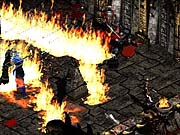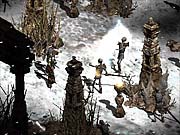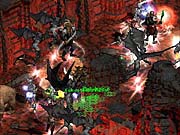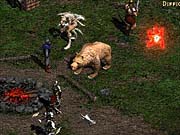Most expansion packs are released when the core game's popularity is beginning to wane, but that's not really the case with Diablo II: Lord of Destruction. In the time since it was released a full year ago, Diablo II has proven to have a very enduring appeal. Players have continued to pit their characters against the collective forces of hell and debate among themselves about which of the five original character classes is the mightiest. If interest in Diablo II has waned at all since last year, then Lord of Destruction will certainly rekindle it. This official expansion introduces two powerful new character classes and scores of other new features and enhancements that all serve not only to bolster the surprising longevity of Diablo II, but also to improve on virtually every aspect of the game.

The most obvious addition in Lord of Destruction is the option to choose from two brand-new character classes, bringing the total number of playable classes in Diablo II to seven. The original classes offered rather diverse play experiences, so you might be skeptical as to whether the expansion classes, the assassin and the druid, would be sufficiently different from the others. Fortunately, they definitely are. In fact, not only are these two classes notably different both from one another and from the other characters, but they're also quite powerful and provide a lot of different tactical options.
The assassin can become skilled in the use different traps, martial arts, and psionic abilities called shadow disciplines. The martial arts are quite interesting--using successive melee attacks, the assassin can charge up various moves that can lead to devastating and rather spectacular results. The assassin can also set up automated sentry defenses to attack her foes with elemental damage, and she has the unique ability to wield the new clawlike weapons found in Lord of Destruction. The druid character is no pushover, either. He can cast powerful natural spells that can rain fiery death down on his foes, create fissures in the earth, cause hurricanes, and more. The druid can also summon animal companions such as ravens, wolves, and bears, and he can himself transform into werewolf or werebear forms. Both the assassin and the druid look as good as all the other classes, and though each is well equipped to handle any particular combat situation, each can specialize in a variety of ways--so, two different druids or assassins of similar level may still have totally different proficiencies, depending on the players' preferences.
If you choose to play as one of these new classes, you must begin the game from scratch, in the very first act. Only after you play through the original four acts in the game will you be able to proceed to the new fifth act, in which your ultimate goal is to defeat Diablo's brother Baal, the Lord of Destruction. The fifth act featured in the Diablo II expansion is certainly the best of them all. Most of it is set around a barbarian village under siege by enemy forces stationed on a nearby mountain. As you fight your way up the mountain, you'll have to contend with powerful foes of all sizes, as well as their demonic artillery weapons. You'll then venture into ice-covered underground caverns and deep into the heart of the mountain, where you'll eventually face your final foe in a very challenging confrontation. This new act isn't just the toughest and most colorful of them all, but its six different quests are rather involved, and it's the also longest act overall--though it's still relatively short and probably won't take more than 10 hours to finish the first time. In turn, though the fifth act is noticeably different from the others, it still follows the same basic blueprint. That is, you'll constantly be fighting droves of enemy forces through expansive and sometimes mazelike randomly generated environments.

The Diablo II expansion includes a lot of other changes and additions to the original game, along with a printed manual that clearly and specifically describes them. One of the most interesting new enhancements in Lord of Destruction is in the way it treats hirelings, the computer-controlled characters you can hire in the towns at the beginning of most of the acts. In Diablo II, hirelings didn't offer any significant benefit, as you had no actual control over them and they weren't nearly strong enough to survive for long. Though you still have no tactical control over them in the expansion, now you can actually outfit your hirelings with armor and weapons and watch as they gain experience levels while fighting alongside you. For a fee, you can resurrect your hireling if he or she is killed, and you can even travel with your hireling from act to act. So, you can actually keep the same hireling with you throughout the entire course of your time spent playing as your particular character. Hirelings are still a liability in some instances, and they generally aren't useful against the boss monsters at the end of each act, but they're now a much more valuable part of the game.
Some of the other changes in Lord of Destruction affect the game's interface and how it plays. All these changes are for the better. You can now access an onscreen minimap instead of Diablo II's full-screen map overlay, and it doesn't clutter your view as much and is generally easier to look at. There are now convenient hotkeys for buying multiple types of common items, such as health potions, and for quickly dropping health potions into your belt for easy access in battle. The game also gives you access to eight additional skill hotkeys, so you can have as many as 16 different character skills mapped to your keyboard. Another very significant interface change lies in the fact that each character can now readily switch between two completely different sets of equipment in his or her hands. For instance, a barbarian might use two swords in most situations, but he can now switch to a more-powerful two-handed polearm with the touch of a keyboard hotkey. This new ability creates a major tactical advantage in many situations, just as it gives the game more depth of play.
Diablo II: Lord of Destruction also adds hundreds of new types of items and magical properties to the game, as well as thousands of possible new combinations of these. Some of the most interesting additions are the new class-specific items, which can only be used by one of the seven classes. These include various special spears for the amazon, animal helmets for the druid, and the claw weapons for the assassin. These items are designed to augment the strengths of their respective classes and encourage more interaction and transaction between Diablo II players on Blizzard's Battle.net player-matching service. Lord of Destruction also adds new high-level elite items that are by far the most powerful in the game, and it doubles the size of your character's stash, letting you safely store plenty more stuff in town.

As with the hirelings, the Diablo II expansion also fulfills the potential of one of the other promising aspects of the original game: In Diablo II, you'd often find equipment with empty sockets, which you could fill with magic gemstones to enhance that equipment. Lord of Destruction takes this to the next level, in large part by making gemstones more common, but also by introducing new types of items you can use with socket equipment--jewels can have random magical properties, while runes have specialized properties of their own that can be greater still if particular runes are laid into an item in the correct order. This way, you can create your own runic, bejeweled, gem-encrusted equipment, and one quest reward in the fifth act even lets you personalize an item with your name, which you can then trade with your friends.
Actually, Diablo II: Lord of Destruction does much to further encourage social interaction in the game. As with Diablo II, in the expansion, the single-player mode is essentially just an offline version of the online game, so your time will be better spent developing an online character that you can use in cooperative or competitive matches with other players. Besides the addition of class-specific items that encourage more trade among players, the two higher difficulty levels in Diablo II (which become available once you finish the game on the previous settings) practically demand that groups of players cooperate in order to succeed. At high levels, some of the monsters are completely immune to certain types of attacks--sometimes even to physical damage. To contend with this, you'll usually need a balanced party of specialized characters. It's still possible to play through the game individually, as all character classes do have different tactical options, especially now that they can easily switch weapons in battle. Yet this and some other enhanced abilities are only possible in the Diablo II expansion, and not in the original game, even though the enhanced difficulty level of Diablo II was made universal as of the recent patches.
These changes sparked some controversy in the Diablo II player community, as some players felt that Blizzard was effectively forcing them to upgrade to the expansion in order to find the items and gain the abilities necessary to deal with the new challenges. Regardless of whether this is true, the fact is that the Diablo II expansion is merely doing its job by adding desirable new features to the core game. That so many players have deemed these changes to be so essential speaks highly of the thought and quality put into the design of Lord of Destruction. Players have also criticized the expansion's attempts to further encourage cooperative play. Cooperative Diablo II is actually great fun, as many of the classes have skills that augment those of the others. However, Blizzard's Battle.net service, whose front-end interface hasn't really changed since the original Diablo, could really benefit from some sort of automated matching option, which could help players get into a game with those of similar experience level. As it is, you still have to manually filter through lists of open games--and rest assured, though you can only play Lord of Destruction with others who have the expansion installed, there will always be plenty of online games to choose from in the foreseeable future.

The Diablo II expansion makes several key aesthetic enhancements to the game. Most notably, it now lets you play in 800x600 resolution, up from 640x480. Though the higher resolution setting adversely affects performance on systems that approach the minimum requirements for Diablo II, for all the rest, this yields a threefold benefit: It cleans up the graphics by making all the characters slightly smaller and thus less pixilated, it cleans up and reduces the size of the onscreen interface bar, and it literally provides a tactical advantage by letting you see more of your surroundings at any given time. Once you try the game in the higher resolution, you'll have a difficult time going back to the standard setting. Besides this, Diablo II: Lord of Destruction includes an excellent new symphonic score for the fifth act and impressive high-quality cinematic sequences for the introduction and ending of the new act.
Though it's a fully featured expansion, Diablo II: Lord of Destruction does pack a hefty retail price of more than $30. So, the question with Lord of Destruction, as with any expansion pack, is whether or not the price suitably justifies the enhancements included. All things being equal, in this case the answer is yes--the Diablo II expansion offers plenty of new features, enough to make you spend at least as much time with the expansion as you have with the original game. The two new classes and the new act make up the brunt of the new content, but the other enhancements add a lot of longevity to the original material as well. Like any good expansion pack, Lord of Destruction doesn't make any major attempts to alter the gameplay that made the preceding game successful, but rather builds on the strengths of its predecessor. It expands the tactical options found throughout the game, and even enhances the graphics. Diablo II: Lord of Destruction has a lot of depth that's readily apparent, yet it takes a long time to really see how much is packed into this great expansion to one of last year's most addicting games.